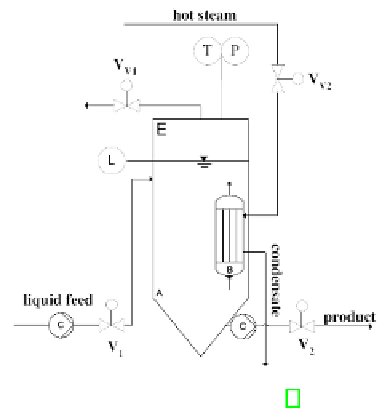Information Technology Reference
In-Depth Information
Fig. 1.
Evaporator model [8]
may visit the four operating modes: NE/NH (
m
=1
), NE/H (
m
=2
), E/H (
m
=3
)
and E/NH (
m
=4
). Thus, the evaporator model possesses the typical features of a
hybrid dynamic system with autonomous mode transitions.
3.1
The Hybrid Evaporator Model
The hybrid model of the evaporator consists of
M
=4
sets of DAEs
f
(
m
)
(
x,x,p
)=
0
,m
=1
, ..., M
. The differential equations represent the mass and energy balances
inside the evaporator. The analytical expressions change when the pressure acting as a
state-dependent switching function
ψ
(1)
(
p
evap
)=
p
evap
− p
c
,p
c
=0
.
4
bar crosses 0:
F
in,liq
· w
i,in
− F
out,liq
· w
i
if
ψ
(1)
(
p
evap
)
<
0
˙
m
i
=
(1)
F
in,liq
· w
i,in
− F
out,liq
· w
i
− F
out,vap
· ξ
i
if
ψ
(1)
(
p
evap
)
≥
0
i
=
A, B, C
U
in,liq
− U
out,liq
+
Q
if
ψ
(1)
(
p
evap
)
<
0
U
=
(2)
U
in,liq
− U
out,liq
− U
out,vap
− H
out,vap
+
Q
if
ψ
(1)
(
p
evap
)
≥
0
.
F
denotes the mass inflow/outflow of the liquid or vapor, respectively. Beside the energy
transfer due to in- and outflows of liquid and vapor the energy balance
U
includes the
heat transfer
Q
from the heatexchanger and the evaporation enthalpy
H
out,vap
.Alge-
braic equations for the thermodynamic relations describe the phase equilibrium between
the liquid and the vapor components according to each mode. Furthermore, the opera-
tion of the heatexchanger switches between the heating and the non-heating mode at the
zero-crossing points of the switching function
ψ
(2)
(
T
heatex
,T
evap
)=
T
heatex
− T
evap
which leads for the heatexchanger to the conditional expressions

Search WWH ::

Custom Search